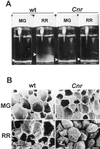Altered middle lamella homogalacturonan and disrupted deposition of (1-->5)-alpha-L-arabinan in the pericarp of Cnr, a ripening mutant of tomato
- PMID: 11351084
- PMCID: PMC102295
- DOI: 10.1104/pp.126.1.210
Altered middle lamella homogalacturonan and disrupted deposition of (1-->5)-alpha-L-arabinan in the pericarp of Cnr, a ripening mutant of tomato
Abstract
Cnr (colorless non-ripening) is a pleiotropic tomato (Lycopersicon esculentum) fruit ripening mutant with altered tissue properties including weaker cell-to-cell contacts in the pericarp (A.J. Thompson, M. Tor, C.S. Barry, J. Vrebalov, C. Orfila, M.C. Jarvis, J.J. Giovannoni, D. Grierson, G.B. Seymour [1999] Plant Physiol 120: 383-390). Whereas the genetic basis of the Cnr mutation is being identified by molecular analyses, here we report the identification of cell biological factors underlying the Cnr texture phenotype. In comparison with wild type, ripe-stage Cnr fruits have stronger, non-swollen cell walls (CW) throughout the pericarp and extensive intercellular space in the inner pericarp. Using electron energy loss spectroscopy imaging of calcium-binding capacity and anti-homogalacturonan (HG) antibody probes (PAM1 and JIM5) we demonstrate that maturation processes involving middle lamella HG are altered in Cnr fruit, resulting in the absence or a low level of HG-/calcium-based cell adhesion. We also demonstrate that the deposition of (1-->5)-alpha-L-arabinan is disrupted in Cnr pericarp CW and that this disruption occurs prior to fruit ripening. The relationship between the disruption of (1-->5)-alpha-L-arabinan deposition in pericarp CW and the Cnr phenotype is discussed.
Figures








References
-
- Albersheim P, Darvill AG, O'Neill MA, Schols HA, Voragen AGJ. An hypothesis: the same six polysaccharides are components of the primary cell walls of all higher plants. In: Visser J, Voragen AGJ, editors. Pectins and Pectinases. Amsterdam: Elsevier Science; 1996. pp. 47–55.
-
- Blakeney AB, Harris PJ, Henry RJ, Stone BA. A simple and rapid preparation of alditol acetates for monosaccharide analysis. Carbohydr Res. 1983;113:291–299.
-
- Blumenkrantz N, Absoe-Hansen G. New method for quantitative determination of uronic acids. Anal Biochem. 1973;54:484–489. - PubMed
-
- Brady CJ. Fruit ripening. Annu Rev Plant Physiol. 1987;38:155–178.
Publication types
MeSH terms
Substances
Grants and funding
LinkOut - more resources
Full Text Sources

